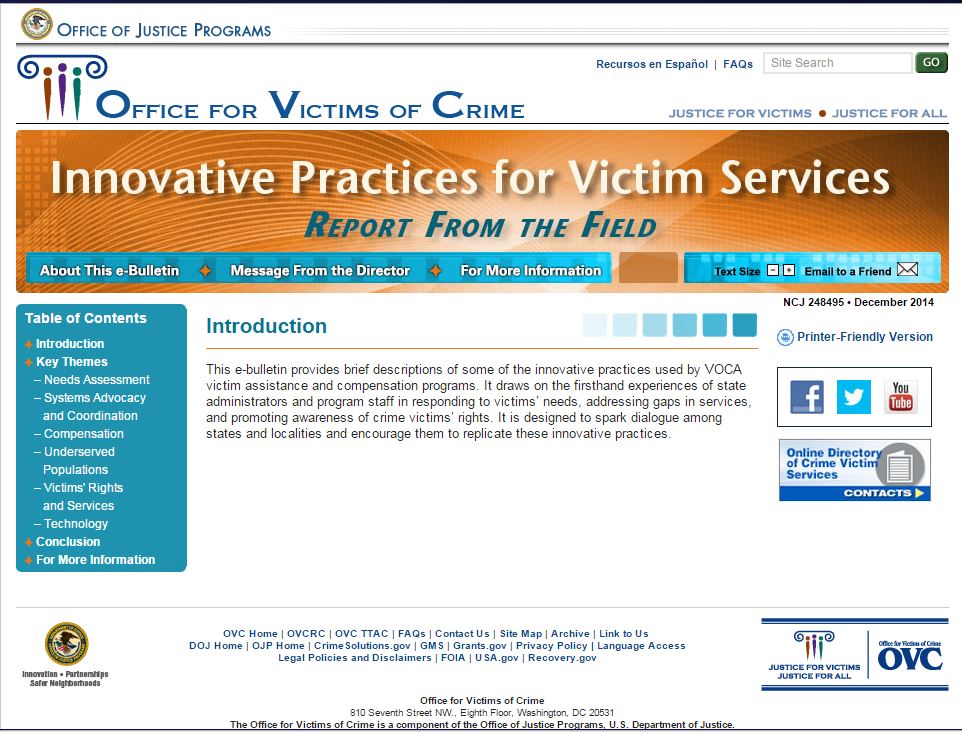VOCA Assistance Highlights
 The VOCA Assistance Formula Grants Program supports more than 4,000 victim assistance programs throughout the Nation each year. Funding for these programs—which state administering agencies award through subgrants to local public agencies and local service providers—provides help for individuals, families, and communities to recover from both the initial trauma and the long-term effects of victimization.
The VOCA Assistance Formula Grants Program supports more than 4,000 victim assistance programs throughout the Nation each year. Funding for these programs—which state administering agencies award through subgrants to local public agencies and local service providers—provides help for individuals, families, and communities to recover from both the initial trauma and the long-term effects of victimization.
Direct assistance to crime victims includes crisis counseling, telephone and onsite information and referrals, criminal justice support and advocacy, emergency shelter, therapy, and additional assistance. Funds may also be used to develop new programs that address emerging needs and gaps in services, which continue to be identified and assessed to improve assistance to victims.
Stories From the States
- The Maryland Governor’s Office of Crime Control & Prevention is expanding Maryland’s state hospital-based domestic violence programs from four to eight. Program services include screening for and documenting abuse, mandated reporting, crisis intervention, safety planning, emotional support, risk assessments, and referrals to community resources such as shelters and counseling. Maryland’s programs also assist hospitals in training medical staff to recognize domestic violence and follow proper screening procedures. Screening programs may decrease hospitalizations, workplace costs and liability, misdiagnosis, and the high cost of specialty care. In addition, hospital staff are more likely to screen all patients for abuse when identifying abuse results in a simple in-house referral.
- To enhance communication with victims, claimants, and family members who struggle to speak, read, write, or understand English, the New York State Office of Victim Services (OVS) conducted a language proficiency survey of all victim assistance programs. The programs reported the capacity to communicate in more than 40 languages, which is a significant benefit given that, according to the 2015 Census, more than 13 percent of the population of New York has limited English proficiency. Many programs also have “I Speak” cards available at their locations so that victims can identify their preferred language. If no staff at the program speak their language, the program can contact OVS for assistance on behalf of the victim. OVS can access the survey information to determine if there is a trained victim advocate at another New York program who speaks that language and can relate to the culture. OVS can then contact the victim advocate to assist with services, compensation applications, and referrals.
- The Colorado Division of Criminal Justice maintains a Victim Rights Act (VRA) Compliance Program to ensure that victims of crime are afforded their state constitutional and statutory rights. A VRA specialist conducts an initial review of formal complaints, which are then submitted to the VRA Subcommittee for a final determination on whether a violation of the VRA occurred. Each year, more than 200 victims contact the program, and an average of 16 victims file formal complaints.
E-Bulletin Highlights Cutting-Edge VOCA Programs
 OVC’s e-bulletin, Innovative Practices for Victim Services: Report From the Field, provides descriptions of some of the innovative practices implemented by VOCA victim assistance and compensation programs throughout the United States. Drawing on the first-hand experiences of state administrators and program staff from 25 states, the report focuses on programs in six key areas: needs assessment, systems advocacy and coordination, compensation, underserved populations, victims’ rights and services, and technology. The e-bulletin is designed to encourage dialogue within the field to implement best practices and promote replication of such innovative programs in states throughout the country.
OVC’s e-bulletin, Innovative Practices for Victim Services: Report From the Field, provides descriptions of some of the innovative practices implemented by VOCA victim assistance and compensation programs throughout the United States. Drawing on the first-hand experiences of state administrators and program staff from 25 states, the report focuses on programs in six key areas: needs assessment, systems advocacy and coordination, compensation, underserved populations, victims’ rights and services, and technology. The e-bulletin is designed to encourage dialogue within the field to implement best practices and promote replication of such innovative programs in states throughout the country.








